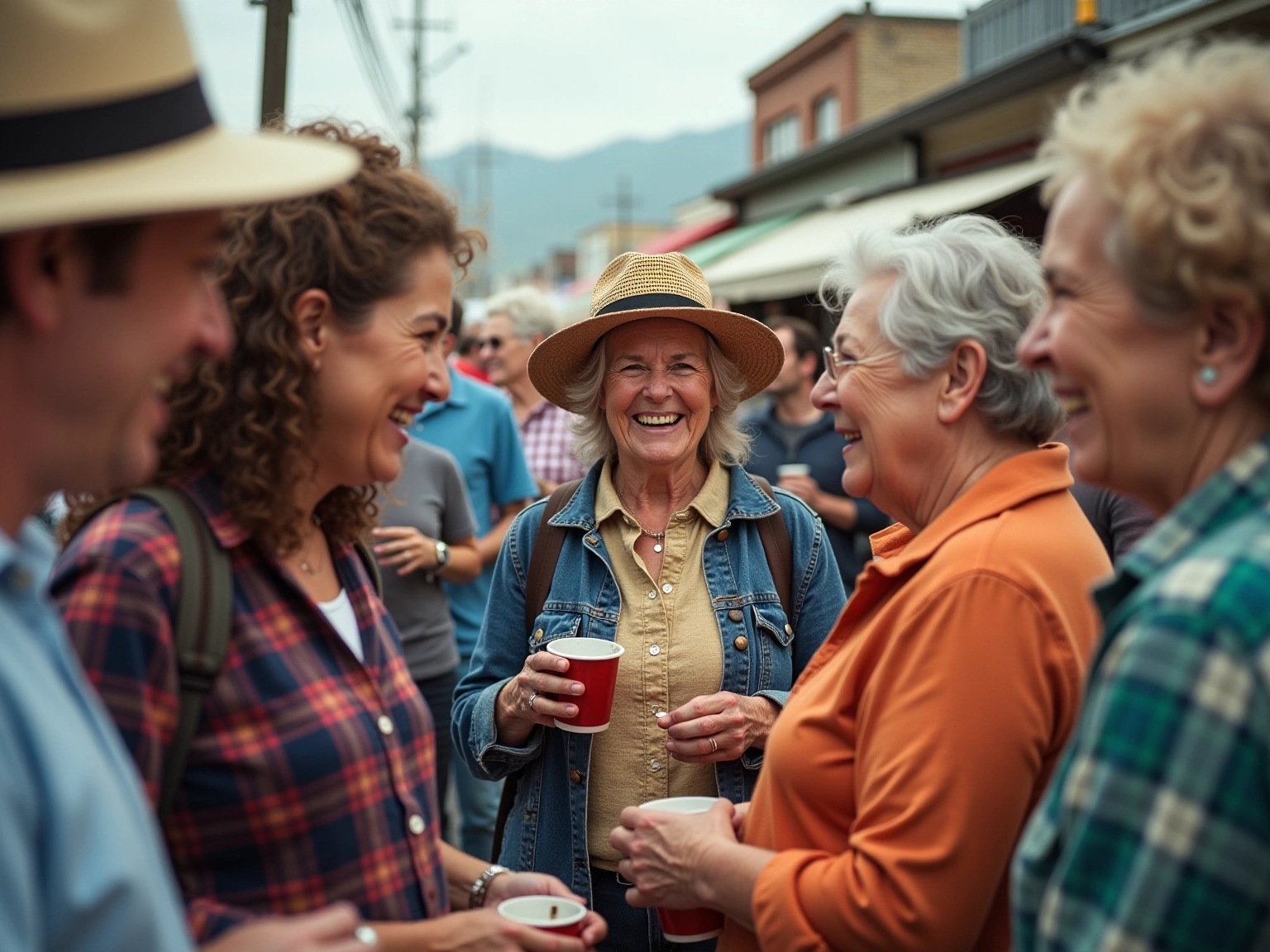Overview
American small towns are truly special, defined by their tight-knit communities, vibrant cultural traditions, and that unique charm that makes you feel right at home. It’s fascinating how these towns adapt to changing demographics and face economic challenges, all while preserving their cultural identity. Local events, volunteerism, and community initiatives play a huge role in this, making these towns vital to the American cultural landscape. Isn’t it exciting to discover how they keep their spirit alive?
Key Highlights:
- American small towns are characterized by tight-knit communities, a leisurely lifestyle, and vibrant cultural traditions.
- Central squares or Main Streets often serve as the heart of these communities, hosting local businesses and gathering spaces.
- Cultural events like harvest festivals and parades foster community pride and identity, with 60% of smaller communities hosting at least one significant event annually.
- Demographic shifts, such as the aging population in places like Fort Myers, highlight the adaptability of small towns to meet changing needs.
- Migration trends show a rise in young adults relocating to small towns for better quality of life, driven by remote work and rising urban living costs.
- Economic challenges include limited job opportunities and aging infrastructure, but local initiatives can revitalize struggling communities.
- High volunteerism rates contribute to the social fabric, promoting community engagement and pride.
- Cultural festivals and local artisans enhance the economic and social landscape of small towns, attracting tourism and preserving heritage.
- Healthcare access remains a significant issue, exacerbated by the opioid crisis, but community health initiatives and telehealth services are emerging solutions.
- The future of small towns looks promising with opportunities for economic growth, local entrepreneurship, and embracing technology.
Introduction
American small towns are truly special, don’t you think? They embody a delightful blend of charm, community spirit, and cultural richness that sets them apart in the vast landscape of the United States. With their tight-knit relationships and a slower pace of life, these towns often serve as the heart of local traditions. Picture vibrant festivals and gatherings that foster a strong sense of identity among residents!
As migration dynamics shift, more individuals are discovering the allure of small towns. They’re drawn by the promise of affordable living, community engagement, and a beautiful connection to nature. However, it’s important to acknowledge that these communities face significant challenges too. Economic fluctuations and health disparities require innovative solutions and collective efforts to overcome.
In this exploration, we’ll delve into the defining characteristics, historical evolution, and modern trends shaping American small towns. Let’s highlight their resilience and the enduring significance they hold in the fabric of American life. You’re in for some exciting discoveries ahead!
Defining American Small Towns: Characteristics and Culture
American rural areas are often filled with tight-knit groups, a leisurely lifestyle, and vibrant cultural traditions. Picture communities where populations range from a few hundred to several thousand residents, creating an intimate atmosphere where social interactions are both frequent and meaningful. A hallmark of these small communities is their central square or Main Street, often lined with local businesses, historic buildings, and gathering spaces that serve as the heart of life.
The culture in these areas is deeply rooted in regional traditions and festivals, which play a crucial role in nurturing a strong sense of identity among residents. Think about yearly events like harvest festivals, parades, and craft fairs that not only honor local heritage but also draw visitors, boosting community pride and economic vitality. In 2025, around 60% of smaller communities host at least one significant cultural event each year—what a fantastic way to see how dedicated they are to keeping local traditions alive!
But there’s more to American rural communities than just their charming features. They often embody a spirit of resilience and adaptability, as demonstrated by case studies like Fort Myers, Florida. With a population of 92,245 in 2021, Fort Myers has become a popular destination for retirees, with 35% of its residents aged 60 and older.
This demographic shift has led to a thriving community that values affordable housing and a relaxed lifestyle, earning Fort Myers a spot among the top 10 cities for retirement according to U.S. News in 2022. This example shows how small communities can evolve to meet the needs of their changing populations while still preserving their unique appeal.
Experts emphasize that the charm of these quaint towns lies in their ability to foster a sense of belonging. As Hayley Raetz, Policy Director at the NYU Furman Center, points out, “This analysis offers a glimpse of the housing landscape in lesser-known and mid-sized cities, emphasizing significant challenges and opportunities for policymakers to contemplate for policy interventions.” This highlights the importance of supporting these communities to ensure they continue to thrive and maintain their distinct cultural identities.
In summary, American small towns are characterized by rich cultural traditions, strong community ties, and a unique charm that resonates with both residents and visitors. Their ongoing evolution reflects the dynamic interplay between tradition and modernity, making them vital parts of the American cultural landscape. By blending expert storytelling with practical travel guidance, Karen LeBlanc, the travel host and author of The Design Tourist, encourages you to discover these places creatively, enriching your travel experiences while deepening your appreciation for the cultural narratives of each destination.
This immersive creative exploration starts with authentic accommodations, where the narrative of place unfolds through art, accessories, and local culture.
A Historical Perspective: The Evolution of Small Towns in America
The development of American small towns traces its origins back to the colonial period, where they served as essential hubs for commerce and social interaction. These communities were vital for settlers, providing essential services and promoting social ties as the nation expanded westward. Over the years, industrialization and urbanization changed the landscape, leading to notable population decreases in many smaller communities as residents moved to urban areas in search of better job opportunities.
Interestingly, Virginia’s population grew by more than 630,000 individuals from 2010 to 2020, reaching 8.63 million. This shift indicates broader demographic changes that have impacted rural community dynamics. It’s fascinating to see how migration patterns continue to shape rural areas, as people seek both belonging and opportunity.
Despite these challenges, recent trends suggest a revived interest in American small towns, fueled by a shared desire for community, affordability, and a more relaxed lifestyle. This resurgence highlights the resilience of these towns, showcasing their ability to adapt to changing societal needs. Historical case studies reveal that even during the colonial period, smaller communities played a crucial role in shaping American history, serving as foundational elements of social and economic life.
As Shonel Sen observes, “Between 2010 and 2020, the population in Virginia grew by over 630,000 individuals, reaching 8.63 million by 2020,” which demonstrates the vibrant character of these areas.
When we think about the historical development of American small towns, it becomes clear that they are not just remnants of the past but lively societies that continue to hold significant cultural and historical importance. The complexities of migration patterns and human behavior, as discussed in the case study on computational models in social sciences, further emphasize the need to understand the underlying factors driving these shifts. By merging skilled storytelling with practical travel guidance, we can deepen our appreciation for the rich narratives that these little communities provide, ultimately enhancing our travel experiences.

Modern Trends: The Migration from Cities to Small Towns
In recent years, a fascinating migration trend has emerged, with many young adults and families relocating from urban centers to American small towns in search of a better quality of life. This shift is largely driven by the rising living expenses in cities, a growing preference for spacious living, and the charm of tight-knit communities. Plus, the COVID-19 pandemic has accelerated this trend, as remote work has freed individuals from the constraints of city jobs, allowing them to choose their living environments more freely.
American small towns are increasingly seen as appealing alternatives, offering not just lower housing costs but also access to nature and a more laid-back lifestyle. This contrast to the hectic pace of city life resonates with many, especially those seeking refuge from urban stress. In fact, migration data shows that by 2025, cities with populations under one million will have experienced an impressive 75% growth in the 25-to-44 demographic, according to Hamilton Lombard, estimates program manager of the Demographics Research Group at the University of Virginia’s Weldon Cooper Center for Public Research.
This shift towards American small towns is evident, with states like Florida attracting retirees at an astonishing rate—nearly 1,000 people moving there daily—drawn by favorable tax conditions and a warm climate. Cities such as The Villages, Sarasota, and Naples exemplify this trend, experiencing rapid growth as they cater to those in search of a more tranquil lifestyle. As households move to less populated areas post-COVID-19, they often highlight community involvement, outdoor activities, and a more relaxed lifestyle as key reasons for their relocation, underscoring the lasting appeal of American small towns.
Additionally, financial pressures faced by homeowners in high-risk areas, with property insurance premiums rising by up to 40% in some states, play a significant role in these migration decisions. The desire for safety is also a major factor, as evidenced by New Hampshire being ranked as the most secure state in America in 2024, making small communities even more attractive for families seeking a safe environment.
Economic Challenges and Opportunities in Small Towns
Small communities in American small towns are navigating some tough economic waters. You might be surprised to learn that these towns often face limited job opportunities, shrinking populations, and aging infrastructure. Many of them rely on just a few industries, making them particularly vulnerable to economic ups and downs. In fact, recent data shows that 52.69% of small communities have a sustainable development score above 0.7255, which hints at the exciting potential for growth and improvement in these areas!
But don’t lose hope just yet! There are some promising opportunities for revitalization in American small towns. Initiatives that support local businesses, boost tourism, and tap into unique cultural resources can breathe new life into struggling communities. For instance, towns that showcase their historical significance or natural beauty often attract more visitors, leading to fresh revenue streams.
Community-driven efforts to enhance local amenities and foster entrepreneurship are absolutely vital for building resilient economies.
Interestingly, case studies reveal that some residents face significant health challenges due to insufficient insurance coverage and high healthcare costs. This has led families to seek affordable healthcare services abroad! It really underscores the need for improved regional healthcare resources and insurance options to promote public health and well-being. One informant shared, “This cards group has kind of turned into a therapy group. Our peer support specialists appear to be with them frequently and engaging with them,” highlighting just how important support initiatives are in tackling these challenges.
Moreover, successful revitalization efforts in small communities often spring from grassroots movements that encourage collaboration among residents, local authorities, and businesses. By focusing on enhancing the quality of life and creating job opportunities, American small towns can truly transform their economic landscape and attract new residents and visitors alike. Experts suggest that nurturing a sense of togetherness and inclusion is crucial for addressing the economic hurdles faced by smaller municipalities in 2025 and beyond.
Additionally, recent research points out the limitations of traditional evaluation methods like Analytic Hierarchy Process and TOPSIS when it comes to handling complex data and system nonlinearity. It advocates for the PCA-CPM model as a more effective way to understand and tackle these issues.
Community and Connection: The Social Fabric of Small Towns
The social structure of little villages is intricately woven from strong local connections and shared experiences. You’ll find that inhabitants actively engage in regional events like fairs, parades, and farmers’ markets. These gatherings not only nurture a sense of belonging but also promote pride among the community. They serve as vital opportunities for social interaction, reinforcing relationships among neighbors and creating a vibrant communal atmosphere!
Moreover, minor municipalities often display a robust culture of volunteerism. Residents participate in service activities and endorse regional initiatives, which significantly enhances the quality of life. For instance, in York, Nebraska, the City joined the Small Cities Pilot Program to improve public engagement. This led to a successful arts and culture survey that captured diverse resident feedback, showing how public involvement can inform local development and strengthen social connections.
Statistics indicate that volunteerism rates in small areas are remarkably high, contributing to a rich social fabric that supports various local initiatives. Participating in these activities not only aids American small towns but also cultivates a sense of purpose and belonging among residents. It emphasizes the significance of social connections in shaping the identity and resilience of small towns throughout the USA. Stephanie Norris, a Senior Research Analyst, notes, “Engaging with reliable voices and groups can assist in decreasing the reluctance that some individuals may have regarding sharing data with survey collectors.”
This highlights the essential role of public involvement in fostering trust and participation. Additionally, initiatives like the Small Town Project in Rocky Ford, Colorado, emphasize the importance of direct engagement and education about the voting process. This further illustrates how active participation can strengthen community bonds. In summary, the social fabric of small communities is not only about shared experiences but also about resilience and active participation in shaping their futures!

Cultural Significance: Traditions and Artistry in Small Towns
American small towns are often vibrant centers of cultural traditions and regional artistry, adding to their unique charm and identity. Annual festivals, like harvest celebrations, art fairs, and historical reenactments, are vital expressions of regional heritage. These events not only keep cherished traditions alive but also attract visitors, boosting the community’s economy.
Did you know that regions hosting cultural festivals often see significant economic benefits? Research shows that tourism can lead to a 4% job growth in urban areas over the past ten years, while rural employment opportunities have declined.
In Erath, Louisiana, you can dive into the authentic Cajun culture through interactive experiences at local museums. Picture yourself participating in spinning wheel demonstrations, Cajun cooking classes, and enjoying live Cajun music performances. These activities provide a fantastic opportunity for families to connect with the local culture. Plus, the museum organizes diverse local events and educational programs, making it a must-visit for anyone eager to explore the rich cultural tapestry of the area.
These interactive experiences not only engage visitors but also contribute to regional tourism revenue and job growth, highlighting the economic impact of cultural initiatives.
Local artisans are essential to these communities, crafting handmade goods that reflect the area’s character and history. Their creations enhance the community culture and foster a sense of pride among residents. The presence of regional artistry boosts the community’s charm, creating a lively atmosphere that resonates with both locals and visitors.
Insights from case studies reveal that the educational and economic outcomes for rural youth are closely tied to the resources available in their areas. This underscores the importance of supporting regional artisans and cultural initiatives. As Arnold wisely noted, “Issues must continue to be studied and researched,” highlighting the need for ongoing exploration of these dynamics.
Beyond economic impacts, the cultural traditions found in small towns enrich the social fabric of life. Statistics indicate that arts, culture, and heritage organizations account for 5% of all not-for-profit entities in Canada, playing a crucial role in community revenues and employment. This emphasizes how collective efforts can enhance health outcomes and address the unique needs of rural populations.
By embracing and promoting regional artistry and cultural traditions, American small towns not only preserve their heritage but also create a dynamic environment that fosters connection and creativity. Community cooperation is vital for improving health outcomes and meeting the specific needs of rural populations, further highlighting the importance of regional initiatives in sustaining these vibrant communities. So, why not explore these cultural experiences and support local artisans? Together, we can ensure the continued vibrancy of our unique heritage!
Facing Challenges: Health and Social Issues in Small Towns
American small towns face a host of health and social challenges that really impact sustainability and quality of life. Access to healthcare can be quite limited, with a lack of medical facilities and professionals leading to significant disparities in health outcomes. Did you know that roughly one in every 500 infants is recognized as deaf or hard of hearing? This highlights the urgent need for specialized services that might not be easily accessible in these areas.
On top of that, the opioid crisis has hit rural areas particularly hard, worsening existing social issues and creating a tangled web of challenges for residents. Tackling these pressing concerns calls for innovative solutions, like telehealth services, which can bridge the gap in healthcare access and provide essential support to those in need. The Biden-Harris Administration’s announcement of over $40 billion to improve broadband access in American small towns and rural areas is a promising step towards enhancing healthcare delivery, as it can facilitate telehealth services and improve overall access to medical care.
Community health initiatives are key players in this landscape. Effective rural maternity care, for example, relies on strong partnerships and local support. Various case studies highlight successful collaborative strategies, such as forming health coalitions that bring together healthcare providers, organizations, and residents to tackle reproductive and maternal health services.
These initiatives not only boost healthcare access but also foster a sense of collective resilience. As Julia Foutz from the Kaiser Family Foundation puts it, “Medicaid plays a central role in ensuring that vulnerable populations have access to necessary healthcare services.”
By encouraging cooperation among local entities, healthcare practitioners, and community members, American small towns can work together to address these challenges. This joint effort is crucial for improving the overall well-being of their neighborhoods, ensuring that residents have the resources and support they need to thrive amidst adversity.

Looking Ahead: The Future of Small Towns in America
The future of American small towns is about to change in exciting ways as they adapt to new demographics and economic landscapes. Recently, we’ve seen a trend of young adults moving to these areas, drawn by a desire for a different lifestyle. This shift is more than just a passing phase; it’s part of a larger movement that started before the pandemic, with small towns increasingly attracting residents aged 25 to 44.
So, how can these towns take advantage of this influx? Minor municipalities have a fantastic opportunity to revitalize their economies and social structures!
To ensure sustainability, it’s essential for these communities to embrace technology and foster local entrepreneurship. For example, did you know that rural populations along Virginia’s Chesapeake Bay have experienced a remarkable 33 percent faster increase in new business applications compared to the state average? This highlights the potential for economic growth! Creating an environment that supports business development is key to attracting and keeping residents.
Moreover, encouraging inclusive participation and preserving cultural heritage will help smaller areas maintain their unique identities while welcoming newcomers. As Ross Devol points out, “the emphasis on attracting and keeping local enterprises, including innovative startups, is a defining factor that sets apart successful micropolitans from their less affluent counterparts.” By leveraging their strengths and tackling the challenges they face, American small towns can not only survive but truly thrive in the coming years, crafting vibrant communities that celebrate both their past and their future.
The Design Tourist emphasizes that blending expert storytelling with practical travel advice can enhance the experiences of those exploring American small towns, further playing a part in their revitalization. So why not dive in and discover what these charming towns have to offer?
Conclusion
American small towns are at an exciting crossroads, blending rich traditions with modern challenges and opportunities. These close-knit communities, bursting with vibrant cultural practices, create meaningful connections among residents as they navigate economic hurdles and health disparities. Their resilience shines through as they adapt to the evolving needs of their populations while keeping their unique charm intact.
Historically, small towns have been vital centers for trade and community interaction. Recently, we’ve seen a renewed interest in these areas, driven by a quest for affordability, community engagement, and a connection to nature—especially accelerated by the COVID-19 pandemic. This shift highlights the ongoing appeal of small towns as sanctuaries from urban stress.
Yet, challenges remain. Economic revitalization calls for innovative solutions, including support for local businesses and better healthcare access. Community engagement and volunteerism are key to enhancing quality of life and fostering a sense of belonging. The cultural significance of small towns, showcased through local artistry and traditions, enriches community life and attracts visitors, boosting local economies.
Looking ahead, small towns can truly thrive by embracing technology, promoting entrepreneurship, and preserving their cultural heritage. As they adapt to changing demographics and economic landscapes, these communities have a bright future filled with growth opportunities. By celebrating their unique identities, American small towns will continue to play a vital role in the nation’s cultural fabric, embodying the spirit of resilience and community that defines them.
Frequently Asked Questions
What are the main characteristics of American rural areas?
American rural areas are characterized by tight-knit communities, a leisurely lifestyle, vibrant cultural traditions, and central gathering spaces such as Main Streets lined with local businesses and historic buildings.
How do cultural traditions play a role in small communities?
Cultural traditions are vital in nurturing a strong sense of identity among residents. Events like harvest festivals, parades, and craft fairs honor local heritage and boost community pride, with around 60% of smaller communities hosting at least one significant cultural event each year.
Can you provide an example of a thriving small community?
Fort Myers, Florida, is an example of a thriving small community, with a population of 92,245 in 2021. It has become a popular retirement destination, with 35% of its residents aged 60 and older, showcasing how small towns can evolve to meet the needs of changing populations.
What challenges do American small towns face?
American small towns face challenges related to demographic shifts, such as population decreases due to urbanization and the need for affordable housing. Experts emphasize the importance of supporting these communities to ensure they thrive and maintain their cultural identities.
How have American small towns evolved over time?
American small towns have evolved from essential hubs for commerce and social interaction during the colonial period to adapting to modern societal needs. Recent trends indicate a revived interest in these towns, highlighting their resilience and ability to provide a sense of community and affordability.
What historical significance do small towns hold?
Small towns have played a crucial role in shaping American history, serving as foundational elements of social and economic life. Their development reflects the complexities of migration patterns and the ongoing importance of community in American culture.
How can travelers appreciate the cultural narratives of small towns?
Travelers can appreciate the cultural narratives of small towns by exploring authentic accommodations and engaging with local art and culture, which enriches their travel experiences and deepens their understanding of each destination’s unique story.

































